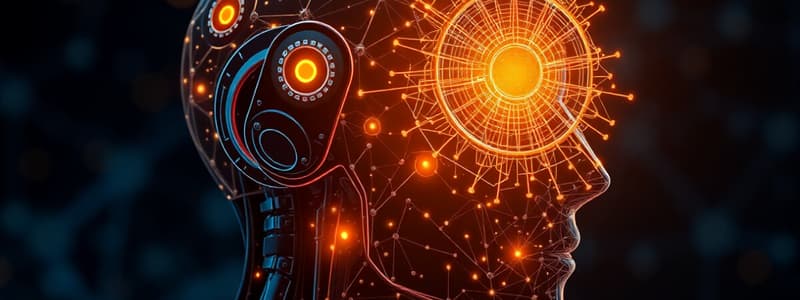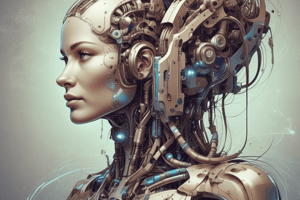Podcast
Questions and Answers
What is the relationship between agents and their environments, and why is this interaction crucial in the context of AI?
What is the relationship between agents and their environments, and why is this interaction crucial in the context of AI?
Agents perceive and act in an environment. This interaction enables learning, adaptation, and goal achievement, forming the basis of intelligent behavior.
Explain how knowledge representation affects the performance of AI systems.
Explain how knowledge representation affects the performance of AI systems.
Effective representation enables efficient reasoning, learning and problem-solving, while poor representation can lead to performance bottlenecks.
In what ways is Natural Language Processing (NLP) integrated with knowledge representation techniques?
In what ways is Natural Language Processing (NLP) integrated with knowledge representation techniques?
NLP extracts structured information from text to populate knowledge bases, while knowledge representation helps NLP systems understand context and meaning.
What role does pattern recognition play in AI systems?
What role does pattern recognition play in AI systems?
How does learning from examples contribute to creating machine learning models?
How does learning from examples contribute to creating machine learning models?
What are the primary differences among supervised, unsupervised, and reinforcement learning?
What are the primary differences among supervised, unsupervised, and reinforcement learning?
Describe how supervised learning algorithms work and list the most common real-world applications?
Describe how supervised learning algorithms work and list the most common real-world applications?
Discuss the benefits and drawbacks of using unsupervised learning in AI.
Discuss the benefits and drawbacks of using unsupervised learning in AI.
How is reinforcement learning put into action in real-world situations?
How is reinforcement learning put into action in real-world situations?
What is linear regression, and where is it used in machine learning?
What is linear regression, and where is it used in machine learning?
What are the key differences between Artificial Narrow Intelligence (ANI), Artificial General Intelligence (AGI), and Artificial Super Intelligence (ASI)?
What are the key differences between Artificial Narrow Intelligence (ANI), Artificial General Intelligence (AGI), and Artificial Super Intelligence (ASI)?
Explain the concepts of production, agents, and environments as they relate to AI systems.
Explain the concepts of production, agents, and environments as they relate to AI systems.
What characteristics define a rational agent in AI?
What characteristics define a rational agent in AI?
What are some factors that determine the nature of an environment in AI?
What are some factors that determine the nature of an environment in AI?
What are the basic concepts and importance of knowledge representation in AI?
What are the basic concepts and importance of knowledge representation in AI?
How does logistic regression differ from linear regression in terms of application and output?
How does logistic regression differ from linear regression in terms of application and output?
Briefly explain Support Vector Machines (SVM) and their function in classification tasks.
Briefly explain Support Vector Machines (SVM) and their function in classification tasks.
How do simpler models like linear and logistic regression help build more involved AI systems?
How do simpler models like linear and logistic regression help build more involved AI systems?
What are the challenges when different forms of learning are applied in machine learning?
What are the challenges when different forms of learning are applied in machine learning?
How does pattern recognition improve decision-making in AI applications?
How does pattern recognition improve decision-making in AI applications?
Flashcards
AI Evolution
AI Evolution
AI history spans from early symbolic reasoning to modern deep learning, marked by periods of enthusiasm and disillusionment.
AI Definition
AI Definition
AI can be described as the ability of a machine to mimic human intelligence, performing tasks that typically require human intellect.
AI Levels
AI Levels
ANI is task-specific, AGI matches human intelligence, and ASI surpasses it.
AI Concepts
AI Concepts
Signup and view all the flashcards
Intelligent Agent
Intelligent Agent
Signup and view all the flashcards
Rational Agent
Rational Agent
Signup and view all the flashcards
Agent-Environment Interaction
Agent-Environment Interaction
Signup and view all the flashcards
Environment Factors
Environment Factors
Signup and view all the flashcards
Impact of Knowledge Representation
Impact of Knowledge Representation
Signup and view all the flashcards
Knowledge Representation
Knowledge Representation
Signup and view all the flashcards
NLP Integration
NLP Integration
Signup and view all the flashcards
Pattern Recognition
Pattern Recognition
Signup and view all the flashcards
Expert System
Expert System
Signup and view all the flashcards
Learning From Examples
Learning From Examples
Signup and view all the flashcards
Learning Types
Learning Types
Signup and view all the flashcards
Supervised Learning
Supervised Learning
Signup and view all the flashcards
Unsupervised Learning
Unsupervised Learning
Signup and view all the flashcards
Reinforcement Learning
Reinforcement Learning
Signup and view all the flashcards
Linear Regression
Linear Regression
Signup and view all the flashcards
Linear vs. Logistic Regression
Linear vs. Logistic Regression
Signup and view all the flashcards
Study Notes
- Artificial Intelligence (AI) history and evolution are key to understanding its current state and future potential.
- AI can be defined as the simulation of human intelligence processes by machines.
- Artificial Narrow Intelligence (ANI) focuses on specific tasks, Artificial General Intelligence (AGI) possesses human-like understanding, and Artificial Super Intelligence (ASI) surpasses human intelligence.
- Production, agents, and environments in AI relate to how AI systems produce actions based on input from their environment, using agents to interact and achieve goals.
- An intelligent agent in AI is an entity that perceives its environment and takes actions to maximize its chances of success.
- A rational agent is characterized by its ability to make optimal decisions to achieve its goals, based on its perceptions and knowledge.
- Agents interact with their environments through sensors and actuators to achieve goals, which is crucial for learning and adaptation.
- Factors determining an environment include accessibility, determinacy, and whether it is static or dynamic, and discrete or continuous.
- Knowledge representation impacts AI system performance by affecting how efficiently and accurately the system can reason and solve problems.
- Basic concepts of knowledge representation involve structuring information in a way that AI systems can use, which is vital for reasoning and decision-making.
- Natural Language Processing (NLP) integrates into knowledge representation by allowing AI to understand and process human language, enhancing its ability to extract and use knowledge.
- Pattern recognition is the process of identifying regularities, and is applied in AI systems for tasks like image and speech analysis.
- An expert system is defined by its ability to emulate decision making, with core components including a knowledge base, inference engine, and user interface.
- Learning from examples helps in developing machine learning models by enabling them to generalize from data and make predictions or decisions without explicit programming.
- Supervised learning uses labeled data, unsupervised learning identifies patterns in unlabeled data, and reinforcement learning learns through trial and error.
- Supervised learning involves training a model on labeled data, with applications like classification and regression.
- Advantages of unsupervised learning include its ability to handle unlabeled data and discover hidden patterns, but it may be less accurate than supervised learning.
- Reinforcement learning is implemented in scenarios like robotics and game playing, where agents learn to make decisions by receiving rewards or penalties.
- Linear regression is a machine learning algorithm, utilized to model the relationship between a dependent variable and one or more independent variables.
- Logistic regression differs by predicting categorical outcomes, while linear regression predicts continuous outcomes.
- Support Vector Machines (SVM) classify data by finding an optimal hyperplane to separate different classes.
- Simple models like linear and logistic regression are foundational for more complex AI systems by providing basic building blocks for prediction and classification.
- Challenges in applying different forms of learning in machine learning include overfitting, underfitting, and the need for large amounts of data.
- Pattern recognition techniques enhance decision-making in AI applications by enabling systems to identify and respond to complex patterns.
- The integration of knowledge representation, NLP, and machine learning is significant for creating AI systems that can understand, reason, and learn in a more human-like manner.
Studying That Suits You
Use AI to generate personalized quizzes and flashcards to suit your learning preferences.




